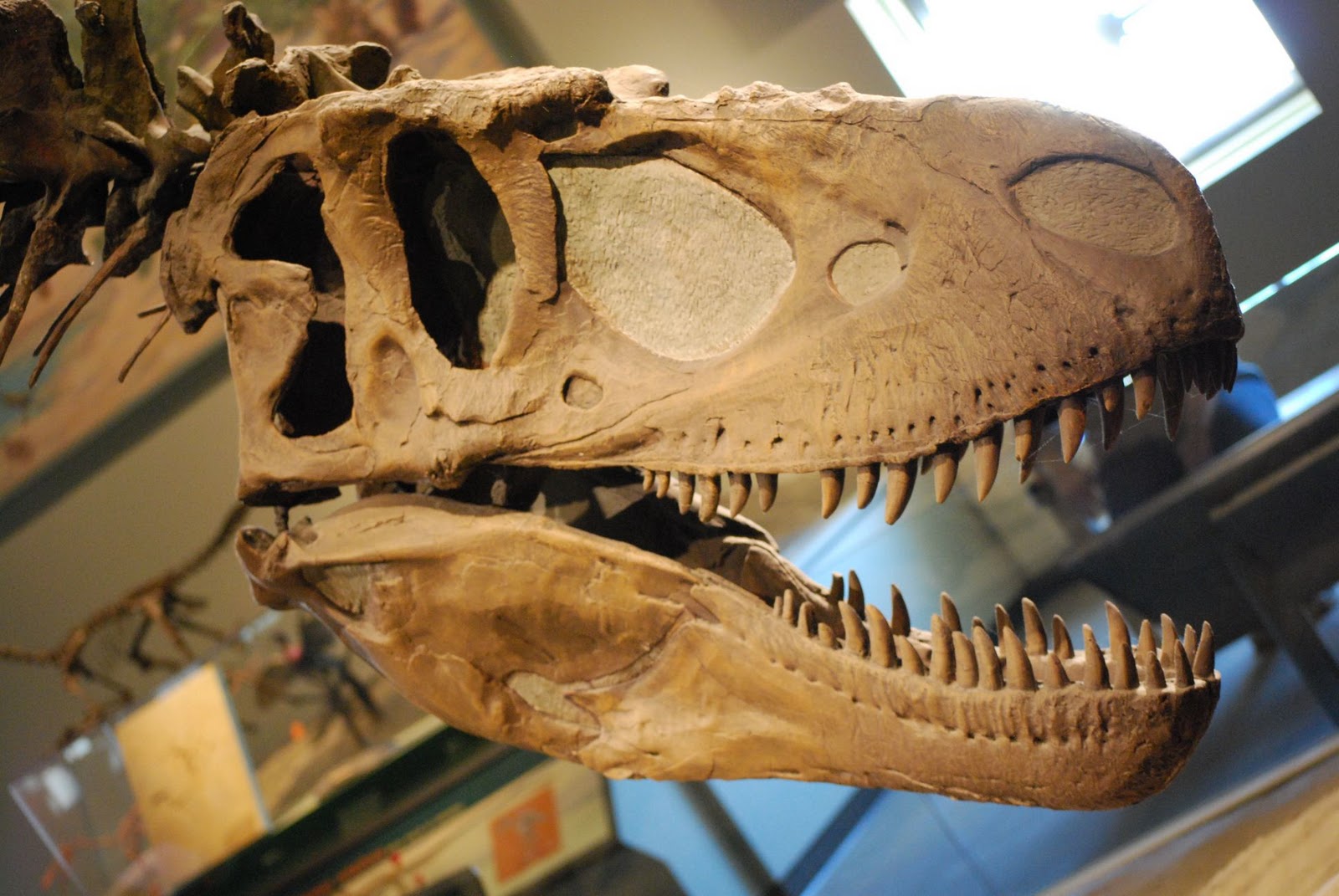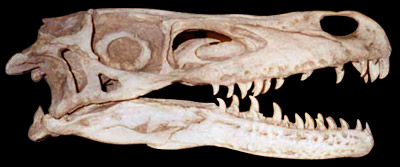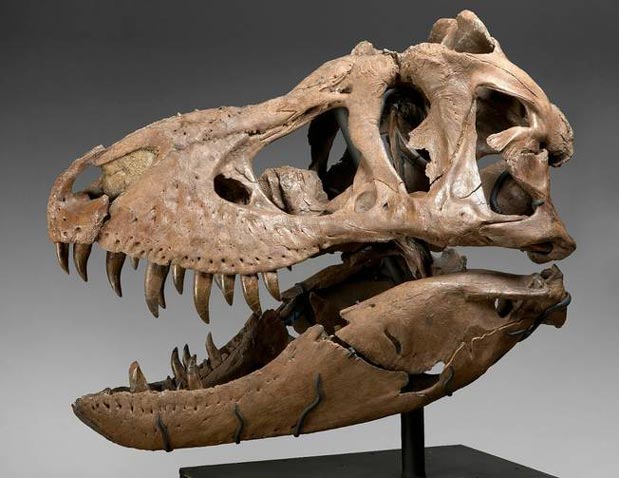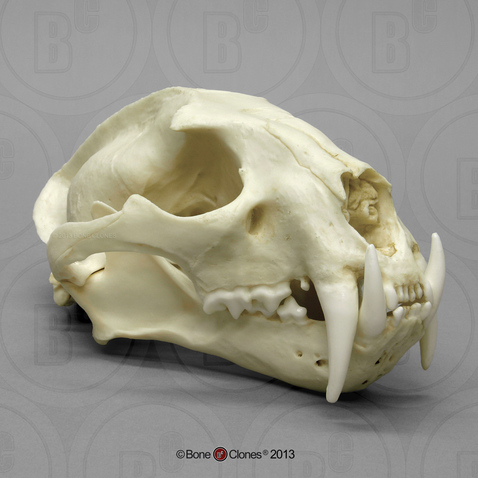Deviation Actions
First, the Lizards:

Iguana iguana

Dracaena guianensis

Varanus salvator

Varanus salvadorii

Cyclura cornuta
Next, the Theropods:

Daspletosaurus sp.

Velociraptor sp.

Tyrannosaurus rex - "Samson"

Tyrannosaurus sp. "Jane"

The birds:

Cathartes aura

Tachyeres brachypterus

Eudromia elegans

Procellaria aequinoctialis

Phalacrocorax sulcirostris

Rhyncheros jubatus

Chunga burmeisteri

Milvago chimachima

Tympanuchus phasianellus

Mergus merganser
Crocodylians:

Crocodylus niloticus

Alligator mississippiensis
Discussion:
Now that we've seen some skulls of various animals, it is interesting to note that birds and crocodylians both have small foramina close to the edge of the lower part of their maxillae. Yet neither of these groups have lips, but either have beaks or just tight, scaled skin.
So which is the better model for theropod dinosaurs? At this point, we can't be sure. But it is of note that the most closely related living taxa to dinosaurs (i.e., birds, crocs, etc.) don't have lips. Also, I'd say that the croc and bird mouth foramina look more similar in size, shape, and distribution to those of theropods than do the foramina of lizards. Albeit, the sample I have above is biased...I can't put every skull picture I find of each lizard, theropod, croc, and bird taxon. That said, I say the theropod mouth foramina distribution, size and number fall into the croc-bird range, not the lizard range.
Another interesting thing, is that the the presence of foramina lining the bones of the mouth does not appear to correlate with the presence or absence of lips. In fact, if you look at the skull of mammals, most of which have lips, you'll notice a conspicuous absence of foramina compared to lizards, dinosaurs, crocs and birds:

This chimpanzee skull, for instance, only has a few, large foramina. Most of which aren't in the area of the lips. Yet chimpanzees have very large lips, and are used quite expressively.
So what does this mean for theropods, and by extension, other dinosaurs? Well, to me it indicates that the preponderance of evidence indicates that they did not have lizard-like or mammal-like lips. To me, they probably had tight, possibly keratinous, skin around the edges of the mouth.
But what about the argument that lips would help protect the teeth from damage, rot, infection and dust and sand and other debris? Well, frankly, crocs get along fine without lips. Also remember, that theropods lost teeth on a regular basis and had new teeth behind each tooth ready to take the place should the current tooth fall out. In fact, theropod teeth are extremely common in the fossil record which would seem to indicate that they did lose them rather frequently--rather like sharks. The fact that many early birds had teeth, and did not have lips, would tend to also favor a lip-less hypothesis for theropods.
There is also another anatomical reason why some theropods probably could not have had lips: their teeth were simply too long!

The teeth in this Gorgosaurus go well past the line of foramina. This would mean the teeth would go past the lips, piercing right through them like the dinosaurian version of a babirusa!

Babyrousa sp.
In fact, the babirusa's teeth don't actually pierce through their lips, but [edit:]
So basically, unless we find a theropod fossil mummy with the soft-tissues of the head exquisitely preserved, there is no reason to think theropods had lips. In fact, there is plenty of circumstantial evidence to indicate the opposite: theropods had no lizard lips! The extant-phylogenetic bracketing (EPB) method indicates no lips for theropods. Also, it does not appear that foramina are correlated with the presence of lips (see crocs and birds). Finally, lips are anatomically implausible for many theropods based on their jaw mechanics.
Finally, I apologize that I haven't referenced the scientific literature much on this. The fact is their are only two papers that deal with this subject that I know of, one by Lawrence Witmer and one by Tracy Ford. I may cover these papers next time in a follow-up post. Also, there is not much published on lizard lips that I could find using Google Scholar (and none that I had access to....scientific papers need to be open access!). Apparently, lips are not that interesting to most biologists and paleontologists. Oh well, I think it's an interesting topic, anyways!
Comments, as always, are welcomed!

Some more thoughts on theropod lips
Thoughts about the size of Dreadnoughtus
A new year, a new blog
Was Amphicoelias a rebbachisaur?
" So which is the better model for theropod dinosaurs? At this point, we can't be sure. But it is of note that the most closely related living taxa to dinosaurs (i.e., birds, crocs, etc.) don't have lips. Also, I'd say that the croc and bird mouth foramina look more similar in size, shape, and distribution to those of theropods than do the foramina of lizards. Albeit, the sample I have above is biased...I can't put every skull picture I find of each lizard, theropod, croc, and bird taxon. That said, I say the theropod mouth foramina distribution, size and number fall into the croc-bird range, not the lizard range."
Related taxa had nothing to do with evolution, birds and crocodiles are related, but they look nothing alike, birds are the closest relatives to theropods, but that doesn't mean all theropods were fluffy and had beaks. In addition, theropods mouth structure looks nothing like crocodiles mouth structure.
As you see in the image above, theropods have very different texture around there snout, there mouth edges are not curved like crocodiles, and they have way less foramina. And no, animals that have fewer than 50 foraminas have flexible oral soft tissues are ther mouth, while animals that a range of 50-100 foraminas has immobile oral soft tissues, and the ones that have more than 100 foraminas don't have lips, similar to crocodiles, and theropods do fit the 50-100 foraminas range, which does suggest the presence of lizard like lips on theropods.
"But what about the argument that lips would help protect the teeth from damage, rot, infection and dust and sand and other debris? Well, frankly, crocs get along fine without lips. Also remember, that theropods lost teeth on a regular basis and had new teeth behind each tooth ready to take the place should the current tooth fall out. In fact, theropod teeth are extremely common in the fossil record which would seem to indicate that they did lose them rather frequently--rather like sharks. The fact that many early birds had teeth, and did not have lips, would tend to also favor a lip-less hypothesis for theropods."
While it's true that theropods could regrow there teeth, lizards could also regrow there teeth, yet, they do have lips, why? Simply because it would be much less resource intensive to have extra oral facial tissue creating a seal when the mouth is closed. Lips are much less expensive than constantly having teeth fall out due to them drying out. and the reason why crocodiles get away with this is because they are highly specialized and spend most of there time in water, even birds don't have there teeth exposed, in case you don't know, geese do actually have teeth
yet, they don't have them exposed, instead, they are covered by there beaks. There's no terrestrial reptile that has it's teeth exposed, so why would theropods have there teeth exposed, this also supports the presence of lips in theropods.
"There is also another anatomical reason why some theropods probably could not have had lips: their teeth were simply too long! The teeth in this Gorgosaurus go well past the line of foramina. This would mean the teeth would go past the lips, piercing right through them like the dinosaurian version of a babirusa!"
Ok, this one doesn't make any sense, there are some animals that have large teeth, yet the have no problem covering them with lips, look at hippos for example
Look at how big these teeth are, yet, they have no problem covering them with lips. Look at clouded leopards teeth
Yet, they have no problem covering them.
and if you look at this gorgosaurus image
the teeth only goes past the foramina line at the very tip, which won't be a problem.
and you might mention that smilodon don't have lips covering there canines, but that's because there teath goes pass the skull, which is not the cause with theropods. in addition, mammals teeth are way more complex than reptiles teeth, so mammals don't have to worry about there drying out, there lips are for milking instead of protecting there teeth, reptiles teeth on the other hand are not as complex, which means that they will dry out if they stayed exposed, and even tho they could regrow there teeth, it would be much easier for them to just have lips protecting them instead of having them oftenly drying out and then regrowing, and the reason why crocodiles could get away with this is because they are semi aquatic.
And if you think about it, wouldn't theropods starve to death before there teeth regrows, theropods needs 1 year in order to regrow there teeth, at that period of time, a theropod could easily starve to death, because it needs it's teeth for hunting and eating flesh, yeah I know, there are some omnivores theropods, but most of them are carnivores, you might mention that some terrestrial crocodiles didn't have lips and had no problem surviving, but that's because crocodiles are cold blooded, they could get all the heat the they need from the sun without wasting energy, unlike theropods, because of that, crocodiles could survive over 3 years without eating anything.
edhttps://youtu.be/1KwCAC8Mu2M
Overall, while I do appreciate the effort put into this, it's misguided to say the least.




